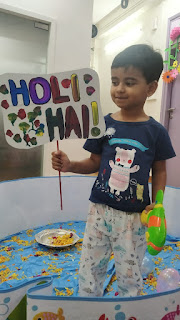 |
| Picture Credit: TOI Holika Dahan, Udaipur |
The festival is celebrated for two days. First day is
celebrated as Holika Dahan. Holi celebrates the killing of Holika in order to
save Prahlad, a
devotee of God Vishnu and thus Holi gets its name. On this day, a bonfire is
lit which is referred to as Holika. It symbolizes the victory of good
over evil. Second day is celebrated as Dhulivandan
or Rang Panchami. On this day, bright colors and happiness soak each and
every corner of the state in India and bring much joy to the lives of the
people. In some regions of India, this festival is celebrated for five days.
Mythology of Holi:
Once there was a demon King Hiranyakashyapu. He had a son, Prahlad. Prahlad was the greatest devotee of Lord Vishnu. Hiranyakashipu insisted that only he be worshipped and would kill anyone who disobeys him. But his son continued to worship Lord Vishnu. This made him furious and he decided to kill his own son, so he called his sister, Holika. She had a magic robe. This robe had the power to save the wearer from burning in fire. Holika sat on a bonfire and tricked Prahlad to sit on her lap. As the fire roared, the magical garment covered Prahlad and he came out of the burning fire safely and Holika was burnt to death. Thus, this day is celebrated with colors to mark the victory of virtue and goodness over evil.
Holika Dahan vidhi:
Holika Dahan is observed on Purnima Tithi in the month
of Phalguna, Shukla Paksha. On
the eve of Holi, typically after a sunset, people gather around a bonfire which
they call Holika Dahan. The ritual symbolizes the victory of good over evil. Pooja is performed in different ways
in different regions.
Pooja Samagri:
Logs of wood, cow dung cake, Gangajal, coconut, a kalash full of water, Batasha or any other sweet, Thread, Diya, Kumkum, Turmeric, Akshada, Incense stick, Dhoop, Gulaal, Flowers.
- Clean the place with cow dung water or Gangajal where you want to perform Holika dahan.
- Pile the logs of wood and cow dung cake in a pyramid shape.
- Three, five or seven rounds of raw thread are tied around the Holika after which it is burnt.
- Keep all pooja ingredients like Akshada, incense sticks, flowers, raw cotton thread, turmeric, batasha, gulal powder and coconut in a plate.
- First seek the blessings of Lord Ganesha. After worshipping Lord Ganesha, you may proceed with Holika Dahan.
- Perform pooja by offering water, haldi-kumkum, akshada, flowers to Holika. After that empty the water in kalash while taking rounds of Holika pile.
- Perform the ritual by facing towards east or north direction.
- Offer prayers to the Lord Narsimha.
- End the prayers by circumambulating the bonfire thrice, five or seven times.
Next morning, on the day of Rang Panchami, the ash from the bonfire is collected and smeared on the body. Some people apply the ash on forehead. The ash is considered ash pious and it is believed that body is purified after applying it.
Celebrations:
On the day of Holi, many sweet dishes are prepared at home like Puran
poli, Shrikhand, Basundi etc. In Maharashtra, People prepare Puran poli as
Naivedyam which they offer to Holika dahan in the evening and there is one
saying in Marathi on this as, “Holi re holi Puranachi Poli”.
On the day of Holi, elder person in the house performs aarti to the children in the family and give them Batasha mala as a sweet and apply colors on their forehead.















Very nice n informative blog.
ReplyDelete